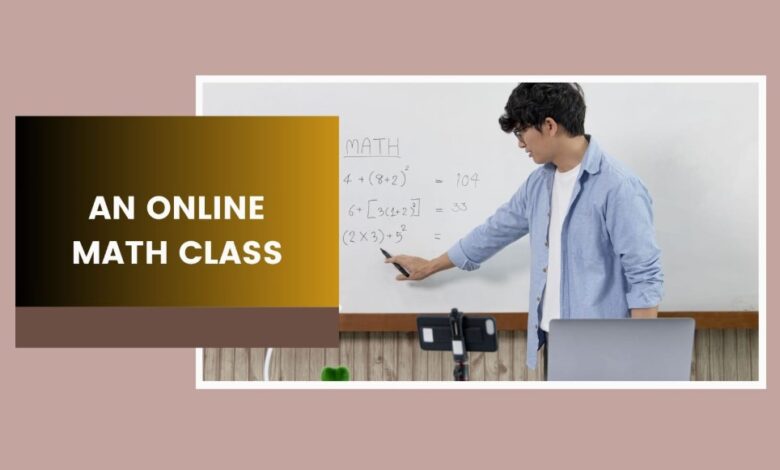How to maintain students’ interest in an online math class?

Nevertheless, teaching mathematics represents a big challenge, especially while virtual. It can even be an enjoyable and interesting subject in the framework of an online setting; therefore, it is essential that instructors maintain the student interacting with the right tools and methodology. With more schools now turning to virtual classrooms, parents and teachers are finding it hard to keep their kids interested in online math classes. Yet when children will be taking an online class, parents are eager to find some effective tools to make them focus and perform well on the class. They frequently ask themselves if they should “pay someone to take my online math class for me.” Although it may sound like a panacea, there are many other strategies that are successful in making children interested in, as well as enthusiastic about, learning mathematics.
So, how can you innovate the ways of teaching mathematics? Making it a given that educators and learners have easy access to technology and other tools that enhance understanding, arouse curiosity, and promote mathematical competence is basic.
Understanding the Challenges of Online Math Courses
Some unique challenges are presented by online mathematics classes. Online learning environments test effective communication and motivation. In traditional classrooms, lecturers may assume that students understand every single non-verbal cue of their participation. Unless a peer or teacher can be reached immediately, children may easily get distracted, lose their interest or get confused by difficult concepts.
Common Challenges Include:
Lack of Social Interaction:
Online class students do not have much face-to-face time with the instructors and other classmates, which makes it tougher to ask questions as well as to get prompt feedback.
Distracting Home:
It becomes very easy to be distracted from work in a home. It may be very challenging for the children to focus on their education when there comes the temptation of video games and other pets in their homes.
Self-motivation problems:
Young children do not possess the self-regulation skills to sustain their attention should they be removed from the structure of a more formalized classroom environment.
Technical difficulties:
It can cause learning to be disrupted and lead to frustration for students. Examples of these difficulties include inadequate internet access and lack of experience with online platforms.
Considering these difficulties, it becomes sense that a lot of parents think about “paying someone to take my online math class for me.” To keep children interested and inspired, parents and teachers should adopt a number of proactive measures rather than exporting the education of their children.
How to Engage Your Students
Because of the epidemic, we now live different lives, so it is essential to establish instructional strategies for mixed or hybrid online learning. It can be difficult to keep pupils engaged in the classroom in any situation, let alone one that is remote. Teaching online allows educators to acquire several important skills.
Being present should be the main consideration for educators. It takes more than just putting yourself on screen to be present. It involves establishing a space where you are approachable, supportive, and empathetic for your students.
If students finds that they do not have any support from the teachers, they ultimately turn to online educational assistance service like pay someone to do my online class for me where they do not have to do anything to get good marks. The experts on your behalf do all your work and score you good grades.
Making an effort to help your students can help them recall the material and develop better study habits for arithmetic. Some of the important pointers are discussed below by using this, teachers can engage students in their online class.
Use Digital Tricks
Without concerns over real-life objects, hands-on activities can now be carried out using computerized manipulatives such as electronic numerals and parts. Unlike mere book reading or workbook answering, pupils would now interact with the content and study mathematics in more concrete ways through electronic manipulatives.
Many digital games are also available that incorporate gaming components into lesson plans to make arithmetic learning enjoyable. These games offer an entertaining setting where students can apply what they have learnt and enjoy themselves at the same time.
Personalized online math instruction
Make the study materials more unique by making instructional movies or adding notes. This is to be motivated to take timely breaks, and do some stretching to keep up with their concentration span. Involve them in discussions using personal questions. Lastly, implement a policy where students will have to switch on cameras throughout class. They need to see you and interact with you as well.
Creative Activities
Students can freely and creatively use their math skills in projects. For example, they may combine a game with teaching other people about the particular concepts embedded in it. Another example is using equations and forms as a way to communicate in order to create mathematical art. For creative projects, when the child is actually developing the talents, such an opportunity provides chances for them to be imaginative while expressing themselves.
Know what drives your students.
The bright side is that just as it would be in any other traditional setting, the secret to involving your home-based learners is knowing how to stir and motivate them to participate in class. Use exactly the same resources you would in a traditional teaching environment – whether you are an online English teacher or a conventional classroom teacher adapting to an online setting.
Play some music to build excitement, or just have fun using the sketching tool. With regard to the pupils you teach, be willing to experiment so that you discover what is helpful for them.
Foster collaboration
Learning does not have to be online only; online learning does not necessarily require isolation. Many tools can facilitate collaborative learning, meaning students are able to work in online teams to address problems or complete assignments. The collaborative efforts help with peer-to-peer contact and have the effect of boosting participation by making learning a more social activity.
Students remain active and involved in the class if opportunities for argument and interaction with other students exist.
Although groups may have several benefits, it must be ensured that the responsibilities and obligation of each student in the group are clearly known so that one student would not dominate the discussion or do all of the work.
Assigning aim to virtual students
Making ensures each session includes a clear framework that you give with your pupils can be a simple approach to incorporate immediate objectives into your virtual classroom. This will help them understand where they are in their educational journey and the context of any activities they are performing. Then imagine how you would praise students for completing assignments or, better yet, for really working hard in a class.
You can even attempt to give your pupils lots of praise, or giving medals and points. You can even try games or a lot of more fun learning activities.
The end is often too far away to be motivating, but you can still make progress with your students by checking in with them to work on goals for the next month, three months, or six months.
Read also: How are Virtual and Augmented Reality Technologies Transforming Professional Training and Education?
Ways in Which Parents Can Take an Active Part
For their kids to succeed in online math programs, parent’s role is quite essential. A parent’s satisfaction and achievement can be greatly impacted by their active participation in their child’s educational journey. Even though some parents sometimes may view alternatives like ” pay someone to do my online class for me” as a quick fix, playing a more involved role will ultimately provide more benefits.
Track Development Continually
To find out where their child could be having difficulty in math, families should routinely monitor their child’s performance. Parents can gain knowledge about their child’s talents and limitations by keeping an eye on projects, visiting meetings with their child’s teacher, and examining grades. Parents can make arrangements for additional assistance if needed, whether it be from a tutor or other internet resources
Offer Confirmatory Feedback
For kids, receiving constructive criticism can be a strong incentive. The trust of a kid and drive can be increased by acknowledging and appreciating tiny victories, such as learning a new math subject or turning in an assignment on time. When a child meets a certain objective, parents can give them prizes like more screen time or an exclusive reward.
Speak with educators
To maintain student engagement, parents and teachers must communicate openly. Parents should get in touch with the teacher for guidance or extra help if their child is having trouble staying focused or understanding a concept.
To assist the youngster in succeeding, teachers might be able to suggest tactics, additional materials, or different teaching approaches.
Conclusion
In order to keep students interested in online math education, parents and teachers must be proactive, creative, and structured. Even while some people might think that “paying someone to take my online math class for me” is an option, it’s important to look at alternative approaches first. Some of them are interactive resources, a dedicated area for a study desk, and real-life examples.
Making learning interesting and relevant for learners would provide them with a real reason for understanding why math applies to everyday life. If all other efforts fail and the child still does not succeed, parents are quite justified in thinking of outsourcing possibilities if they want to give their child the individualized attention that he or she would need to be successful.






